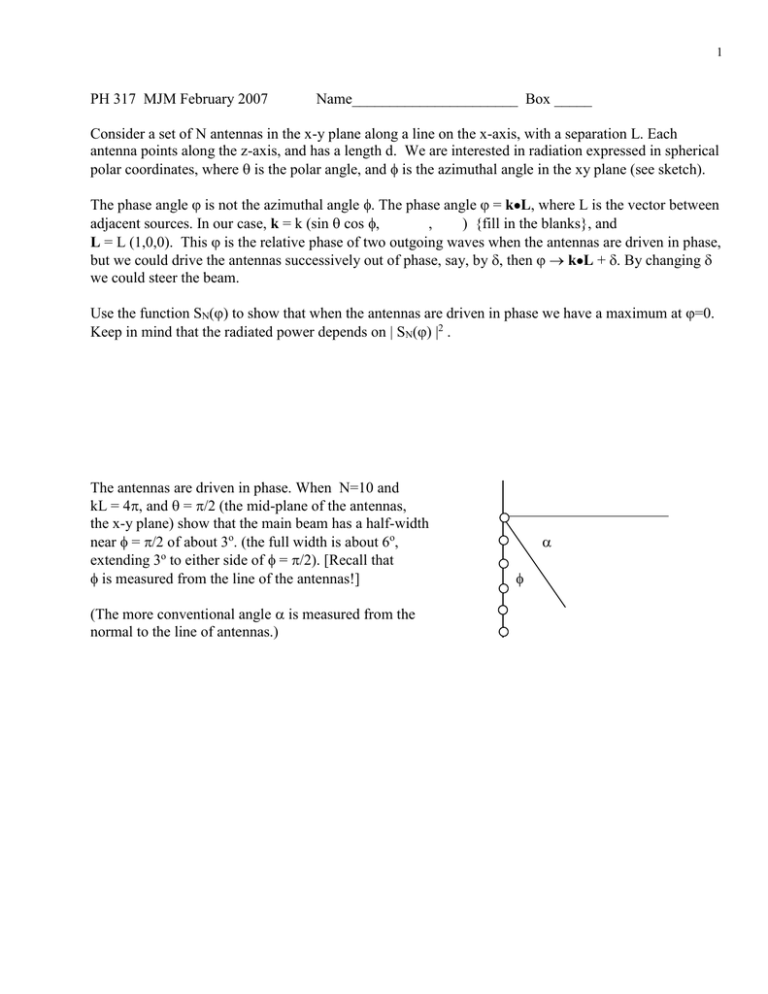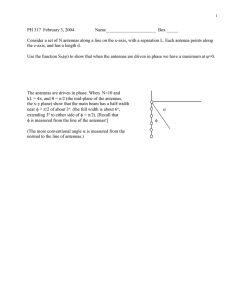PH 317 MJM February 2007 Name______________________ Box _____
advertisement

1
PH 317 MJM February 2007
Name______________________ Box _____
Consider a set of N antennas in the x-y plane along a line on the x-axis, with a separation L. Each
antenna points along the z-axis, and has a length d. We are interested in radiation expressed in spherical
polar coordinates, where is the polar angle, and is the azimuthal angle in the xy plane (see sketch).
The phase angle is not the azimuthal angle . The phase angle = kL, where L is the vector between
adjacent sources. In our case, k = k (sin cos ,
,
) {fill in the blanks}, and
L = L (1,0,0). This is the relative phase of two outgoing waves when the antennas are driven in phase,
but we could drive the antennas successively out of phase, say, by , then kL + . By changing
we could steer the beam.
Use the function SN() to show that when the antennas are driven in phase we have a maximum at =0.
Keep in mind that the radiated power depends on | SN() |2 .
The antennas are driven in phase. When N=10 and
kL = 4, and = /2 (the mid-plane of the antennas,
the x-y plane) show that the main beam has a half-width
near = /2 of about 3o. (the full width is about 6o,
extending 3o to either side of = /2). [Recall that
is measured from the line of the antennas!]
(The more conventional angle is measured from the
normal to the line of antennas.)
2
Find the azimuthal angle for us to observe the first 'side lobe', on either side of the main lobe. (The
angle at which the first main side lobe exists). { You can model this in RHWavint. Go to N Source
Interference then to N sources in a line, and set N = 0. Then adjust wavelength and separation to
correspond to kL = 4. A wavelength of 0.4 pixels is not a bad start. You can drag the buttons around,
and it may be best to drag to the left to the lowest value, then use a right arrow to gradually increase the
value. }
You have to do the work analytically, but the model can help you visualize and check.
Show that the second side lobe occurs at = 0, or = /2.
(over)
3
The 10 antennas still have kL = 4. Now they are driven so that a phase difference exists between each
adjacent antenna ( between 1 and 2, between 2 and 3, etc.) When the phase difference between
antenna elements is = -/3, find the angle at which we have the main lobe maximum [ it will no
longer be at = /2, or = 0 ].
Change the spacing L between each of the 10 antennas (expressed as a number of wavelengths, or kL as
a phase difference) so that the large side lobes will be suppressed, and the main lobe will have a halfwidth of less than 10o. You must the analytical work, and check with RHWavint.


![EEE 443 Antennas for Wireless Communications (3) [S]](http://s3.studylib.net/store/data/008888255_1-6e942a081653d05c33fa53deefb4441a-300x300.png)
